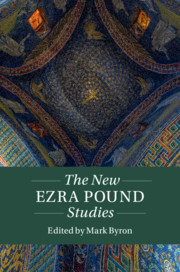Book contents
- The New Ezra Pound Studies
- Twenty-First-Century Critical Revisions
- The New Ezra Pound Studies
- Copyright page
- Contents
- Notes on Contributors
- Key to Abbreviations
- Editor’s Introduction
- Part I Pound’s Texts
- Part II Ezra Pound and Asia
- Chapter 8 Pound’s Representation of the Chinese Frontiers
- Chapter 9 ‘A Treasure Like Nothing We Have in the Occident’
- Chapter 10 Ezra Pound and Chinese Poetry
- Part III Culture and Politics
- Index
- References
Chapter 9 - ‘A Treasure Like Nothing We Have in the Occident’
Ezra Pound and Japanese Literature
from Part II - Ezra Pound and Asia
Published online by Cambridge University Press: 17 October 2019
- The New Ezra Pound Studies
- Twenty-First-Century Critical Revisions
- The New Ezra Pound Studies
- Copyright page
- Contents
- Notes on Contributors
- Key to Abbreviations
- Editor’s Introduction
- Part I Pound’s Texts
- Part II Ezra Pound and Asia
- Chapter 8 Pound’s Representation of the Chinese Frontiers
- Chapter 9 ‘A Treasure Like Nothing We Have in the Occident’
- Chapter 10 Ezra Pound and Chinese Poetry
- Part III Culture and Politics
- Index
- References
Summary
Pound’s relationship with Japanese literature can be broadly divided into three areas: the influence of ‘hokku’ on his work, his interest in ‘Noh’ drama, and his own impact on Japanese literature. The first of these has, until recently, dominated in English-language Pound scholarship about Japan.
- Type
- Chapter
- Information
- The New Ezra Pound Studies , pp. 141 - 156Publisher: Cambridge University PressPrint publication year: 2019



